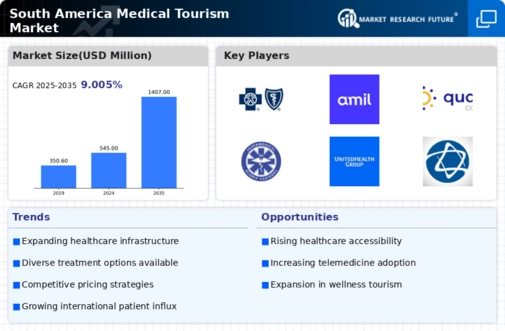The South America Medical Tourism Market presents a dynamic landscape characterized by an increasing influx of international patients seeking high-quality healthcare services at competitive prices. As globalization continues to shape industries, the region has successfully positioned itself as a viable alternative for medical procedures, offering a blend of advanced medical technology and a range of specialized services. Countries like Brazil, Argentina, and Colombia have emerged as principal destinations for medical tourists, driven by a combination of affordability, expertise, and an evolving healthcare infrastructure.
The competitive ecosystem in this market comprises both local and international healthcare providers, insurance companies, and travel agencies, all vying for the attention of potential medical tourists by promoting their unique offerings and partnerships. Blue Cross Blue Shield has a significant presence in the South America Medical Tourism Market, known primarily for its robust insurance services which cater to a diverse patient population. The brand's strengths lie in its extensive network of healthcare providers across the region, allowing for seamless access to high-quality medical facilities and professionals.
With an established reputation for reliability and coverage, Blue Cross Blue Shield enhances the confidence of medical tourists in seeking treatment abroad. The company's strategic partnerships with local hospitals and clinics further bolster its offerings, ensuring that patients can receive complex procedures, preventative care, and rehabilitation services without high costs. This focus on patient care, combined with its extensive customer service capabilities, offers a compelling proposition for those exploring medical options in South America.Amil plays a crucial role in the South America Medical Tourism Market, with a broad spectrum of healthcare solutions catered specifically towards international patients.
Known for its comprehensive health insurance plans, Amil has built a strong market presence by creating a diversified portfolio that encompasses preventive care, specialized treatments, and wellness programs. The company's strengths are evident in its advanced healthcare facilities, state-of-the-art technology, and collaborations with top medical professionals. In addition, Amil has pursued strategic mergers and acquisitions that enhance its capabilities and service offerings, further solidifying its reputation in the region. Committed to delivering high-quality healthcare services, Amil ensures that medical tourists have access to essential care options, all while prioritizing affordability and excellence in patient experience in South America.

















Leave a Comment